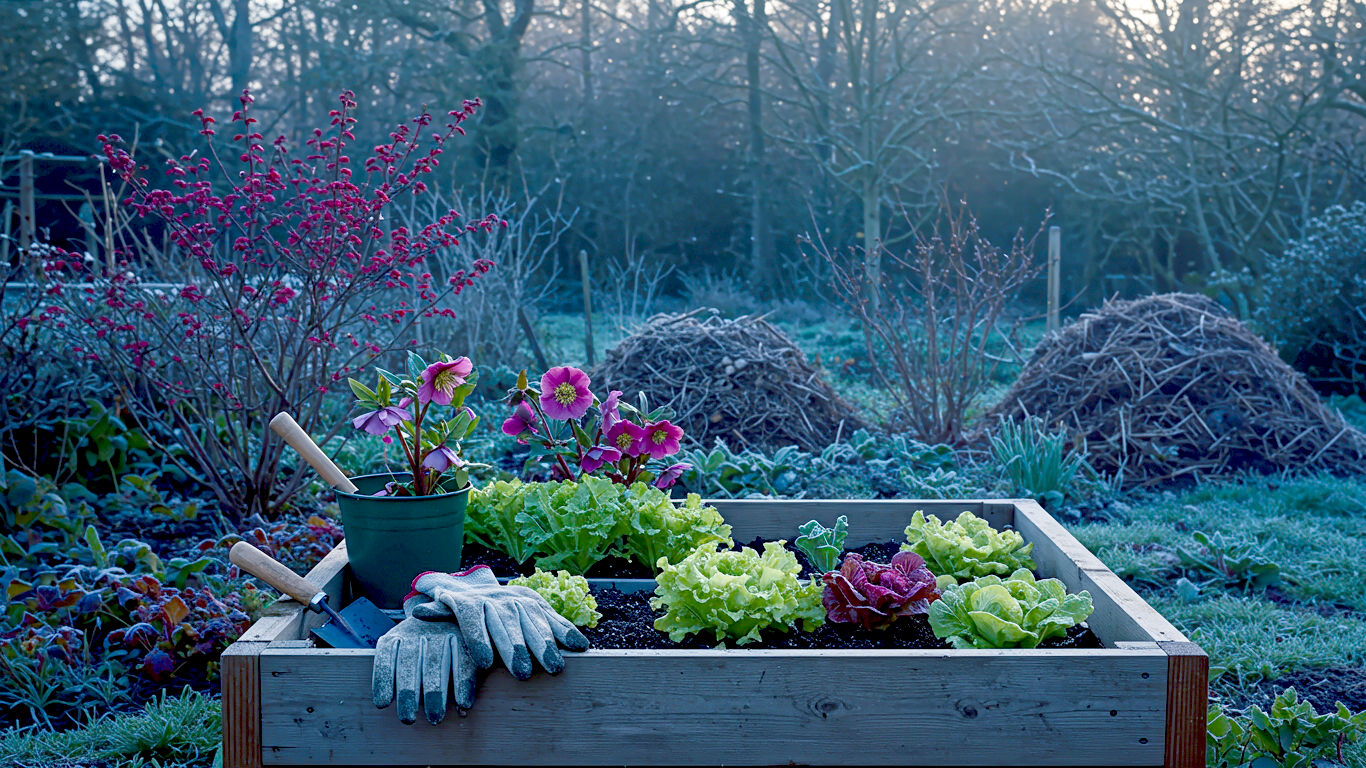The Great British Winter Garden: Your Definitive Guide to a Thriving Yard in the Cold
Your ultimate guide to UK winter gardening. Discover essential jobs, what to plant, how to protect plants from frost, and tips for a beautiful garden all year.

This post may contain affiliate links. If you make a purchase through these links, we may earn a commission at no additional cost to you.
When the last of the autumn leaves have fallen and a sharp frost sketches silver patterns on the lawn, it’s tempting to hang up your gardening gloves, retreat indoors, and wait for spring. Many people think of the garden in winter as a dormant, lifeless place. But that couldn’t be further from the truth.
The British winter garden isn’t dead; it’s just sleeping. It’s a time of quiet preparation, subtle beauty, and essential jobs that lay the groundwork for a spectacular year ahead. Think of it as the garden’s secret season—a chance to tidy, plan, protect, and even plant. With the right approach, you’ll find there’s a surprising amount of life and colour to be enjoyed.
This guide is your ultimate companion for the colder months. We’ll walk you through everything you need to know, from protecting your precious plants against the harshest weather to choosing veg you can plant right now. So, grab a cuppa, get comfortable, and let’s explore how to make your garden thrive all winter long.
Don’t Hang Up Your Trowel Just Yet: Why Winter is a Gardener’s Secret Weapon
The biggest mistake any gardener can make is seeing winter as an ending. It’s not. It’s the vital, quiet chapter that makes the rest of the story possible. The work you put in between November and February is a direct investment in the health, beauty, and productivity of your garden for the entire coming year.
The bare branches of winter reveal the garden’s skeleton, giving you a unique chance to assess its structure, plan changes, and tackle jobs that are impossible when everything is in full leaf. It’s a time for foresight. Pruning a dormant rose bush correctly now will reward you with masses of fragrant blooms in June. Spreading a thick layer of compost on an empty bed now will feed the soil, ready to nourish your tomato plants next summer.
This guide is designed to be your month-by-month friend, giving you a clear list of tasks that will keep you connected to your outdoor space and ensure it bursts back into life with vigour when the days start to lengthen.
The Big Winter Tidy-Up: More Than Just Raking Leaves
A good winter regimen starts with a thorough but thoughtful tidy-up. This isn’t about making the garden sterile; it’s about disease prevention, pest control, and preparing the ground for what’s to come.
Clearing the Decks for Spring
Fallen leaves from deciduous trees can look lovely for a while, but if left in a thick, wet mat on your lawn or borders, they can cause problems. They block light from reaching the grass, causing yellow patches, and can create a damp, airless environment where fungal diseases and slugs love to thrive.
Your Leaf Plan:
- Rake them up: On a dry day, rake all the leaves from your lawn and paths.
- Sort them out: If you’re dealing with tough, slow-to-rot leaves like oak or sycamore, it’s a good idea to run a lawnmower over the pile first. This shreds them into smaller pieces, which helps them break down much faster.
- Make leaf mould: Don’t throw those leaves away! They are garden gold. Pack the damp leaves into black bin bags, poke a few holes in the sides with a fork, and store them out of sight behind the shed. In a year, you’ll have a crumbly, partly decomposed leaf mould perfect for mulching. In two years, you’ll have a fine, dark, nutrient-rich soil conditioner that’s brilliant for potting mixes.
A Clean Bill of Health for Your Beds
Once the leaves are up, turn your attention to the flower beds and veg patch.
- Remove spent annuals: Pull up any old bedding plants or annual vegetables that have finished for the year. If they look healthy, they can go straight onto the compost heap.
- Cut back perennials: Many herbaceous perennials die back in winter. You can cut the brown, collapsed stems down to just above ground level. However, a word of caution: don’t be too tidy. The hollow stems and seed heads of plants like echinacea, sedum, and Verbena bonariensis can provide vital shelter for overwintering insects like ladybirds. They also look beautiful when dusted with frost and provide food for birds. A good compromise is to cut back the really messy, collapsed foliage but leave a few of the more structural seed heads standing until late winter.
- Check for disease: As you tidy, keep an eye out for signs of disease, like black spot on rose leaves. Make sure you collect and bin (or burn) any diseased material rather than composting it, as this can spread the problem.
- Weed: Winter is a great time to tackle stubborn perennial weeds like couch grass, dandelions, and bindweed. The soil is often soft, and with other plants dormant, it’s easier to see what you’re doing and get the entire root out.
Tool Care and Shed TLC
A wet, miserable winter afternoon is the perfect time to give your tools some love. A well-maintained tool is easier to use, works better, and will last for decades.
- Clean them: Use a stiff brush and some water to remove all the caked-on mud from your spades, forks, and trowels. A wire brush is great for stubborn bits.
- Sharpen them: You’d be amazed at the difference a sharp edge makes. Use a metal file to sharpen the cutting edge of your spade and hoe. For secateurs and shears, you might need a special sharpening stone. Always file away from the blade.
- Oil them: To prevent rust, wipe over all the metal parts with an oily rag. You can use general-purpose oil like 3-in-1, or even just old engine oil. For wooden handles, sand them down to remove any splinters and rub in some linseed oil to stop them from drying out and cracking.
While you’re at it, have a general sort-out in the shed or garage. Check if your remaining seeds are still in date, tidy your pots, and make a list of any supplies you’ll need for spring.
Tuck Your Plants In: The Art of Winter Protection
The British winter can be unpredictable. One week can be mild and damp, the next can bring a hard frost or biting winds. Protecting your more vulnerable plants is one of the most important winter jobs.
Understanding the Enemy: How Frost Damages Plants
So, what does frost actually do? When water freezes, it expands. Plants are mostly made of water, held inside tiny, rigid structures called cells. When the water inside a plant cell freezes, the ice crystals expand and burst through the cell wall, just like a can of fizzy drink left in the freezer. This damage is irreversible and is why frosted plants often turn to a blackened, mushy mess when they thaw. Tender and evergreen plants are most at risk.
Your Frost-Fighting Toolkit
You don’t need lots of fancy equipment. A few simple materials can make all the difference.
- Mulching: This is the gardener’s equivalent of putting a duvet on the bed. A thick layer (at least 2-3 inches) of organic matter spread over the soil acts as an insulator, protecting the plant’s roots from the worst of the cold. Good materials for mulching include: well-rotted garden compost, bark chips, leaf mould, or even straw. Apply it around the base of tender shrubs, perennials, and fruit trees, but be careful not to pile it up right against the stem, as this can cause it to rot.
- Horticultural Fleece: This lightweight, white fabric is a must-have. It lets light and water through but traps a layer of air underneath, which provides several degrees of frost protection. You can drape it directly over hardy veg like winter salads or create a frame around a more tender shrub (like a bay tree in a pot) and wrap the fleece around that. It’s much better than bubble wrap for plants, which can trap condensation and lead to rot.
- Cloches: A cloche is just a cover placed over an individual plant. You can buy fancy Victorian-style glass bell jars, but a plastic fizzy drink bottle with the bottom cut off works just as well for protecting small, young plants.
- Pot Protection: Plants in pots are far more vulnerable to cold than those in the ground. The soil in the ground is a great insulator, but in a pot, the roots are exposed to the cold air from all sides.
- Move them: The easiest solution is to move pots to a more sheltered spot, like against the wall of the house or into a porch.
- Group them: Huddle several pots together. They will help to insulate each other.
- Wrap them: If you can’t move a large pot, wrap the pot itself (not the plant) in a layer of bubble wrap or hessian sacking to protect the roots.
- Lift them: Use “pot feet” or a few bricks to raise your pots off the ground. This stops the base from getting frozen to the patio and helps prevent waterlogging, which is a major killer in winter.
Bringing the Tender Folk Indoors
Some plants simply won’t survive a British winter outdoors. These “tender perennials” need to be brought into a frost-free place like a greenhouse, a conservatory, or a cool windowsill.
- Dahlias: After the first frost has blackened their foliage, cut the stems down to about 6 inches. Carefully dig up the tubers, shake off the loose soil, and let them dry for a few days. Then store them in a tray or cardboard box filled with dry compost or sand, somewhere cool but frost-free.
- Pelargoniums (often called Geraniums): Pot them up and bring them indoors to a light, cool spot. Water them very sparingly—just enough to stop them from completely drying out.
- Fuchsias: Many fuchsias are hardy, but the more tender varieties will need protection. You can treat them like pelargoniums or store them dormant in a cool, dark place.
What to Plant in Winter: Yes, You Can!
It might seem strange, but winter is a key planting season for certain things. The soil is cool and damp, which helps new roots establish without the stress of summer heat.
The Winter Veg Patch
You won’t be harvesting tomatoes, but you can definitely get a head start on next year and even grow a few things for a winter crop.
- Garlic: Winter is the perfect time to plant garlic cloves. They need a period of cold to encourage them to split into bulbs. Plant individual cloves about 2 inches deep and 6 inches apart, with the pointy end facing up. ‘Early Purple Wight’ is a great variety to try.
- Onions and Shallots: You can plant onion “sets” (tiny bulbs) in autumn and winter for an early crop next summer. Shallots planted now will be ready to harvest from early July.
- Broad Beans: Sowing broad beans like ‘Aquadulce Claudia’ in late autumn or early winter gives them a head start. They will grow slowly through the cold weather and give you a much earlier crop than spring-sown beans.
- Hardy Salads: If you have a greenhouse, cold frame, or even just a sheltered, sunny spot, you can grow some surprisingly tough salad leaves. Try lamb’s lettuce (corn salad), winter purslane, and land cress.
A Splash of Winter Colour
Your garden doesn’t have to be a sea of brown and green. There are some heroic plants that flower in the depths of winter, bringing much-needed cheer.
- Hellebores: Often called the Christmas or Lenten Rose, these are the undisputed stars of the winter garden. Their beautiful, bowl-shaped flowers come in shades of white, pink, deep purple, and green, and they don’t mind frost or snow one bit.
- Winter-flowering Jasmine (Jasminum nudiflorum): This cheerful climber produces bright yellow, star-shaped flowers on bare green stems. It’s perfect for training against a wall or fence.
- Witch Hazel (Hamamelis): A fantastic shrub that produces clusters of spidery, fragrant flowers in shades of yellow, orange, and red on bare branches.
- Pots and Baskets: For instant cheer, you can’t beat winter-flowering pansies and violas. They will flower their hearts out on any mild day. Combine them in a pot with some hardy cyclamen and trailing ivy for a display that will last for months.
The Best Time for Bare-Root
From November to March, while they are dormant, you can buy many trees, shrubs, hedging plants, and roses “bare-root.” This means they come with no soil around their roots. They are much cheaper than pot-grown plants and often establish more quickly. Plant them as soon as you get them, making sure their roots don’t dry out. It’s an incredibly cost-effective way to plant a hedge or start an orchard.
Winter Soil Secrets: Building a Better Foundation
Healthy plants start with healthy soil. Winter is the ideal time to improve your soil’s structure and fertility.
To Dig or Not to Dig?
For generations, gardeners have practiced “winter digging,” where they turn over the soil in their veg patch and leave it in rough clods. The idea is that the frost will get into the clods and break them down, improving the soil structure—this is especially useful for heavy clay soil.
However, a “no-dig” approach is becoming increasingly popular. No-dig gardeners believe that digging damages the delicate soil ecosystem of worms, fungi, and microbes. Instead, they simply spread a thick layer of compost or well-rotted manure over the surface of the soil in winter and let the worms do the work of pulling it down.
Which is best for you? If you have very heavy, compacted clay, a one-off dig can help to open it up. But for most gardens, the no-dig method is easier, better for the soil, and means fewer weeds.
Feed Your Soil
Whichever method you choose, winter is the time to add organic matter. This is the single best thing you can do for your garden. Organic matter improves drainage in heavy soils, helps light soils hold onto water, and provides a slow-release source of nutrients for your plants. A 2-3 inch layer of well-rotted manure, garden compost, or mushroom compost spread over your beds is the perfect winter feed.
The Winter Snip: A Guide to Pruning
Pruning can feel daunting, but it’s one of the most important gardening skills. Winter is the main pruning season for many plants.
Why Prune in Winter?
When a plant is dormant and has no leaves, it’s much easier to see its shape and structure. You can clearly see any branches that are dead, diseased, or rubbing against each other. Pruning now, while the plant is “asleep,” is also less of a shock to its system and encourages it to put on lots of strong, healthy growth in the spring.
What to Prune Now
- Apple and Pear Trees: Prune these to create an open, goblet-like shape that lets air and light into the centre of the tree. This helps ripen the fruit and reduces the risk of disease.
- Bush and Climbing Roses: For bush roses, aim to cut them back by about a third to a half, removing any spindly or dead stems. For climbers, cut back any side-shoots that have flowered to about two or three buds from the main framework.
- Wisteria: This climber needs two prunings a year. The winter one is crucial for getting lots of flowers. Cut back the long, whippy shoots that grew over the summer to just two or three buds.
- Summer-flowering shrubs: Shrubs that flower in summer on new wood, like Buddleja (butterfly bush) and Lavatera, can be cut back hard in late winter or early spring.
What NOT to Prune
Knowing what to leave alone is just as important. Avoid pruning:
- Stone fruits: Plums, cherries, and apricots should be pruned in summer, as pruning in winter makes them vulnerable to a fungal disease called Silver Leaf.
- Spring-flowering shrubs: Plants like Forsythia and Weigela flower on wood that grew last year. If you prune them now, you’ll cut off all the flower buds. Wait until they have finished flowering in spring.
Your Garden is a Winter Restaurant: Caring for Wildlife
A good garden is a living ecosystem, and winter is a tough time for wildlife. A few simple actions can make your garden a vital haven for birds and insects.
Feeding the Birds
Birds use up a lot of energy just staying warm. Providing food and water can be a lifesaver.
- What to feed: A mix of foods will attract a wider range of birds. High-energy options like sunflower hearts, nyjer seeds, peanuts (in a proper mesh feeder), and suet or fat balls are ideal. You can also put out things like chopped apples and pears for blackbirds.
- Fresh water: A shallow dish of fresh water is just as important for drinking and bathing. Make sure to break the ice on frozen mornings.
- Keep it clean: Clean your feeders and bird bath regularly with hot, soapy water to stop diseases from spreading.
Don’t Be Too Tidy
As we mentioned earlier, resisting the urge to be perfectly tidy is great for wildlife.
- Leave seed heads: The seed heads of plants like teasels and sunflowers provide a natural larder for goldfinches.
- Make a log pile: A simple pile of logs and branches in a quiet corner will provide shelter for everything from beetles to hibernating hedgehogs.
- Check before you cut: Always check long grass or compost heaps for sleeping wildlife before you start strimming or turning them with a fork.
Greenhouse and Lawn Care in the Cold
Your greenhouse and lawn also need a different kind of attention in winter.
The Glasshouse in Winter
- Clean it: Wash the glass inside and out to let in as much precious winter light as possible.
- Insulate it: If you want to keep it frost-free, line the inside with a layer of horticultural bubble wrap.
- Ventilate it: Even on cold days, it’s important to open the vents for a while on sunny mornings. This prevents the air from becoming stagnant and damp, which encourages grey mould.
Winter Lawn Rules
The best thing you can do for your lawn in winter is very simple: stay off it. Walking on wet or frozen grass compacts the soil and damages the turf.
- Give it one final, slightly higher cut in late autumn if the weather is mild.
- Use a rake to gently sweep up any remaining leaves or worm casts on dry days.
- That’s it. Leave it alone until spring.
Armchair Gardening: Planning for the Year Ahead
One of the greatest joys of winter gardening is that a lot of it can be done from the comfort of your favourite armchair.
The Joy of Seed Catalogues
When the seed catalogues start arriving through the letterbox in January, it’s a sign that spring is on the way. This is the time for dreaming. Flick through the pages and decide what new vegetables you want to try or what colour scheme you want for your flower borders. Make a list, place your order early to get the best choice, and get excited.
Sketch It Out
You don’t need to be an artist. Grab a piece of paper and a pencil and sketch out a rough plan of your garden or allotment.
- Mark where you grew everything last year.
- Plan a simple crop rotation for your veg. This just means not growing the same type of vegetable (e.g., potatoes, brassicas, beans) in the same spot year after year, which helps to prevent the build-up of pests and diseases in the soil.
- Think about where you could add a new plant, a seating area, or a compost bin.
Conclusion: The Quiet Reward of a Winter Garden
Winter in the garden isn’t a void. It’s a pause, a breath. It’s a time to appreciate the stark, honest beauty of a bare tree against a grey sky, the vibrant stems of a dogwood, or the plucky flowers of a snowdrop pushing through the cold earth.
The work you do now—the tidying, the mulching, the pruning, the planning—is an act of faith. It’s a promise you make to your future self and your future garden. By embracing this quiet, preparatory season, you’re not just ensuring a garden that is healthier and more beautiful; you’re staying connected to the gentle, constant rhythm of the natural world. So don’t pack your trowel away. The secret season awaits.
Further Reading & Resources
- Royal Horticultural Society (RHS): https://www.rhs.org.uk/advice/in-month/winter
- Gardener’s World: https://www.gardenersworld.com/seasonal-advice/winter/
- The Wildlife Trusts: https://www.wildlifetrusts.org/actions






